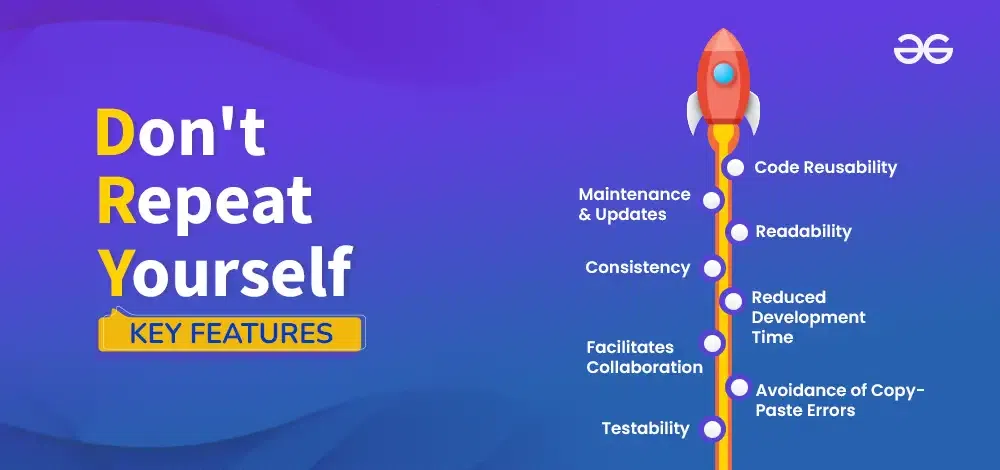DRY Principle
(2025-08-17T12:26.439Z)
Perplexity Query
(2025-08-17T12:26
.439Z)
Question:
Write a comprehensive one-page article about "DRY Don't Repeat Yourself principle in Software Engineering".
Response from sonar-pro:
DRY (Don't Repeat Yourself) Principle in Software Engineering
The DRY (Don't Repeat Yourself) principle is a foundational concept in software engineering that stresses the importance of minimizing repetition of code and data across a system.
[rmk0ed]
[lao2q3]
By ensuring that every piece of knowledge or logic is represented only once, DRY empowers developers to build maintainable, error-resistant, and efficient systems—a critical consideration as software grows in complexity and scale.
[rmk0ed]

At its core, DRY dictates that "every piece of knowledge must have a single, unambiguous, authoritative representation within a system".
[rmk0ed]
[t6obq3]
This principle, first formulated by Andy Hunt and Dave Thomas in The Pragmatic Programmer, extends beyond mere code: it encompasses database schemas, documentation, test plans, and build systems.
[rmk0ed]
For example, if a calculation, data model, or configuration appears in multiple places, any needed change would require updates in each instance. DRY combats this by abstracting repeated logic into reusable components, functions, or modules.
[lao2q3]
In object-oriented languages, inheritance and class hierarchies facilitate the reuse of shared logic, while in functional programming, small composable functions play this role.
[lao2q3]
A practical illustration of DRY is a web application with multiple forms that validate email addresses using identical logic. Placing this validation logic in a single email validation function ensures that future adjustments—such as updating the regular expression—propagate throughout the entire codebase.
[cw2nco]
In a data engineering context, DRY may be observed in centralized data models or template engines, where the same SQL filter conditions are reused across a multitude of reports, ensuring consistency and reducing maintenance effort.
[cw2nco]
Approaches to achieve DRY include encapsulating logic in functions or classes, centralizing configuration constants, and breaking software into modular, reusable components.
[lao2q3]
The benefits of DRY are extensive:
- Improved readability: Clean, focused modules make the codebase easier to understand and reason about. [cw2nco]
- Increased reliability: By avoiding redundancy, errors that might occur in repeated sections of code are minimized. [lao2q3]
However, challenges arise in the pursuit of DRY. Premature abstraction—generalizing code before understanding all use cases—can lead to inappropriate, overcomplicated abstractions that hinder adaptability.
[99tbig]
As Sandy Metz famously noted, "Duplication is far cheaper than the wrong abstraction".
[99tbig]
Developers are encouraged to seek a balance: duplicate small amounts initially, and abstract only when clear patterns emerge.
[99tbig]

Current trends show broad adoption of the DRY principle across traditional software engineering, data engineering, and cloud-native software development.
[cw2nco]
[t6obq3]
Tools and languages are evolving to encourage DRY practices—frameworks like React encourage component-based architecture, while SQL transformation platforms (e.g., dbt) natively facilitate code reuse and modularization.
[t6obq3]
Leading technology firms and open-source communities increasingly advocate for strict adherence to DRY to enhance productivity and code quality.
[rmk0ed]
[t6obq3]
In analytics engineering, DRY is helping teams manage sprawling codebases and complex logic mappings by leaning on reusable, referenceable code models.
[t6obq3]
Recent developments such as low-code platforms and improved IDE tooling further underscore the value of DRY by enabling automatic refactoring, code analysis, and template-driven development. Companies with large, distributed teams especially benefit, as centralizing and reusing logic ensures knowledge remains consistent and accessible.
[cw2nco]
[t6obq3]

Looking ahead, the future of DRY lies in continued automation and intelligent tooling. Machine learning-assisted code review, context-aware refactoring, and advanced code generation promise to further reduce incidental duplication and identify optimal abstraction points. As software ecosystems become larger and more interconnected, strict application of DRY will remain a cornerstone for delivering adaptable and robust solutions.
The DRY principle remains a vital practice for software engineers seeking to write resilient, scalable, and maintainable systems. As new technologies and architectures develop, the core tenet of representing each piece of knowledge only once will continue to guide best practices in building the software of tomorrow.
[rmk0ed]
[lao2q3]
[t6obq3]
Citations
[rmk0ed] 2025, Aug 07. Don't repeat yourself - Wikipedia. Published: 2005-12-01 | Updated: 2025-08-07
[lao2q3] 2025, Aug 17. Don't repeat yourself(DRY) in Software Development - GeeksforGeeks. Published: 2024-02-22 | Updated: 2025-08-17
[cw2nco] 2025, Aug 15. DRY (Don't Repeat Yourself) Principle - Explanation & Examples. Published: 2024-09-16 | Updated: 2025-08-15
[99tbig] 2025, Aug 16. The DRY Principle: Benefits and Costs with Examples. Published: 2021-08-09 | Updated: 2025-08-16
[t6obq3] 2025, Aug 06. DRY principles: How to write efficient SQL - dbt Labs. Published: 2025-04-02 | Updated: 2025-08-06